111. Northern Shoveler Spatula clypeata (Europese Slopeend)
Order: Anseriformes. Family: Anatidae
Description
Length: 44-52 cm. Wingspan: 73-82 cm. Sturdy dabbling duck with short neck and long, spatulate bill.
Male unmistakeable in breding plumage. Irridescent green head, black and grey wings. Broad white collar and chestnut belly. In flight, pale blue forewing feathers are revealed, separated from the green speculum by a white border. Very large black spatula shaped bill.
In non-breeding (eclipse) plumage, the male resembles the female, but the male can be identified by a white streak just in front of the eye.
Female brown with green speculum. Very large grey and orange spatula shaped bill
Similar species: The plumage of the female is similar to that of a female Mallard the bill being the major distinguishing feature. Female differs from female Cape Shoveler in being speckled brown and much paler overall, especially around the head and neck, and in having white edges to tail.
Distribution
Wide ranging Northern Hemisphere species. Breeds in North America and northern Eurasia, heading south in the non-breeding season to West Africa and the area from Egypt to eastern Zambia. It is a rare vagrant to southern Africa with most records in the Western Cape and Gauteng, with about half a dozen more elsewhere in South Africa, northern Namibia, northern Zimbabwe and southern Mozambique.
Habitat
Freshwater lakes and ponds. It generally favours shallow freshwater wetlands in grassland, with plenty of mud and invertebrates.
Diet
Mainly aquatic invertebrates, doing most of its foraging by dabbling, diving or up-ending.
Breeding
The nest is a shallow depression on the ground, lined with plant material and down, usually close to water.
Call
Quiet took by male and quack by female.
Listen to Bird Call.
Status
Rare vagrant.
Africa Wild Bird Book
Northern Shoveler Photos
111. Northern Shoveler Spatula clypeata
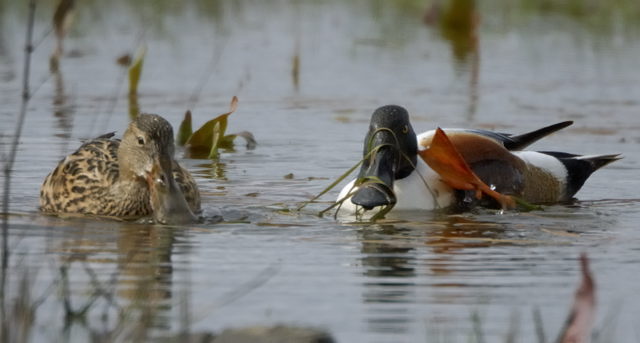
Female on left, male on right
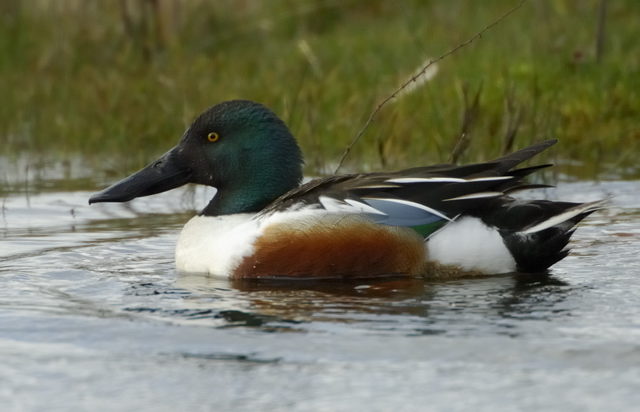
Male
Links:
Oiseaux net
Wikipedia
Malcolm Alexander Ogilvie, Steve Young: Wildfowl of the World

Female on left, male on right

Male
Links:
Oiseaux net
Wikipedia
Malcolm Alexander Ogilvie, Steve Young: Wildfowl of the World
Cape Shoveler
112. Cape Shoveler Spatula smithii (Kaapse Slopeend)
Order: Anseriformes. Family: Anatidae
Description
53 cm. Large, spatulate shaped bill. Body and back geryish brown and finely speckled.
Male: The lesser and median coverts are pale blue, separated from the metallic dark bottle-green secondaries by a white wing bar (only visible when preening, or in flight). The legs are a bright orange in colour. Male has a paler head and yellower eye than the female.
Adult female is duller, but more mottled than male. Head and neck are darker and less contrasted than in male. Wings are duller, greyish, with indistinct pale tips on great coverts. Eyes are dark brown and bill is slightly smaller. Legs and webbed feet are greyish-yellow.
Juvenile resembles female, with more mottled plumage on upperparts.
Similar species: Both sexes can be distinguished from all ducks except the vagrant Northern Shoveler by the long, black, spatulate bill. Cape Shoveler is much darker and stockier than female Northern Shoveler.
Distribution
Found mostly in South Africa, with smaller populations in Namibia, Botswana, Zimbabwe, southern Angola and Zambia. In South Africa it is particularly common in the Western Cape and Kruger National Park.
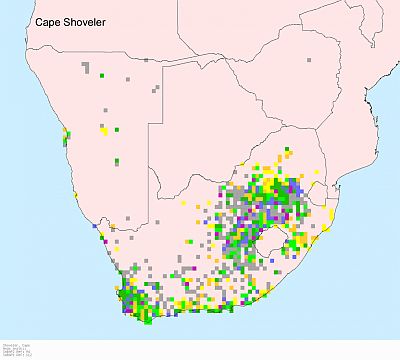
Habitat
Freshwater lakes and ponds.
Diet
Cape Shovellers feed in shallow water by dabbling: Swimming forward with the head held low and the bill being used to filter food out of the water. The diet includes aquatic invertebrates and tadpoles; aquatic plants and seeds are eaten rarely.
Breeding
Monogamous, solitary nester. The courtship is quite elaborate, with head-shaking, strange calls and aerial chases. The nest is built solely by the female, 2-10 days before egg laying starts, consisting of a scrape in dry ground. This is filled with leaves and stems and usually lined with down feathers. It is normally placed on islands, always surrounded by thick vegetation. The egg laying season is year round, peaking from July-November. It lays 5-13 eggs, in successive days. It is prone to clutch desertion, if constantly disturbed. Incubation is done solely by the female, for 27-31 days. The female normally takes two one hour breaks a day, covering the eggs with nesting material to join the male in feeding, preening and bathing. The chicks are taken care of by their mother, with the male helping by chasing predators away. The chicks can usually fly at 63 days old, after which they become independent.
Call
Male a low rattling, guttural rrar, female a short loud quack. Listen to Bird Call.
Status
Endemic. Common resident.
Order: Anseriformes. Family: Anatidae
Description
53 cm. Large, spatulate shaped bill. Body and back geryish brown and finely speckled.
Male: The lesser and median coverts are pale blue, separated from the metallic dark bottle-green secondaries by a white wing bar (only visible when preening, or in flight). The legs are a bright orange in colour. Male has a paler head and yellower eye than the female.
Adult female is duller, but more mottled than male. Head and neck are darker and less contrasted than in male. Wings are duller, greyish, with indistinct pale tips on great coverts. Eyes are dark brown and bill is slightly smaller. Legs and webbed feet are greyish-yellow.
Juvenile resembles female, with more mottled plumage on upperparts.
Similar species: Both sexes can be distinguished from all ducks except the vagrant Northern Shoveler by the long, black, spatulate bill. Cape Shoveler is much darker and stockier than female Northern Shoveler.
Distribution
Found mostly in South Africa, with smaller populations in Namibia, Botswana, Zimbabwe, southern Angola and Zambia. In South Africa it is particularly common in the Western Cape and Kruger National Park.

Habitat
Freshwater lakes and ponds.
Diet
Cape Shovellers feed in shallow water by dabbling: Swimming forward with the head held low and the bill being used to filter food out of the water. The diet includes aquatic invertebrates and tadpoles; aquatic plants and seeds are eaten rarely.
Breeding
Monogamous, solitary nester. The courtship is quite elaborate, with head-shaking, strange calls and aerial chases. The nest is built solely by the female, 2-10 days before egg laying starts, consisting of a scrape in dry ground. This is filled with leaves and stems and usually lined with down feathers. It is normally placed on islands, always surrounded by thick vegetation. The egg laying season is year round, peaking from July-November. It lays 5-13 eggs, in successive days. It is prone to clutch desertion, if constantly disturbed. Incubation is done solely by the female, for 27-31 days. The female normally takes two one hour breaks a day, covering the eggs with nesting material to join the male in feeding, preening and bathing. The chicks are taken care of by their mother, with the male helping by chasing predators away. The chicks can usually fly at 63 days old, after which they become independent.
Call
Male a low rattling, guttural rrar, female a short loud quack. Listen to Bird Call.
Status
Endemic. Common resident.
Cape Shoveler Photos
112. Cape Shoveler Spatula smithii (Kaapse Slopeend)
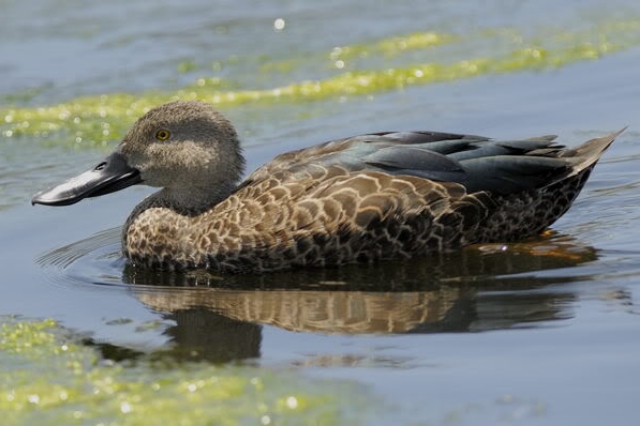 © Dewi
© Dewi
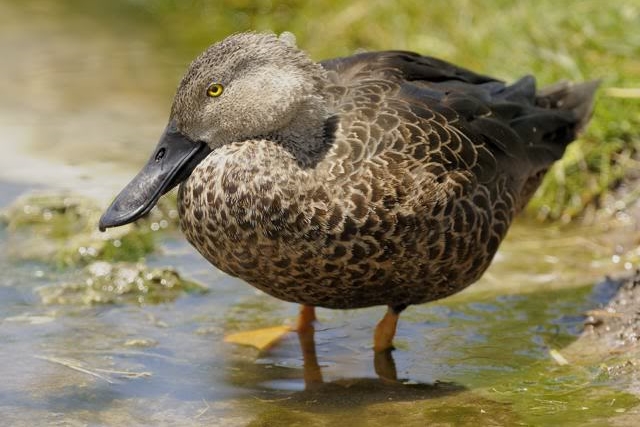 © Dewi
© Dewi
 © nan
© nan
Lamberts Bay
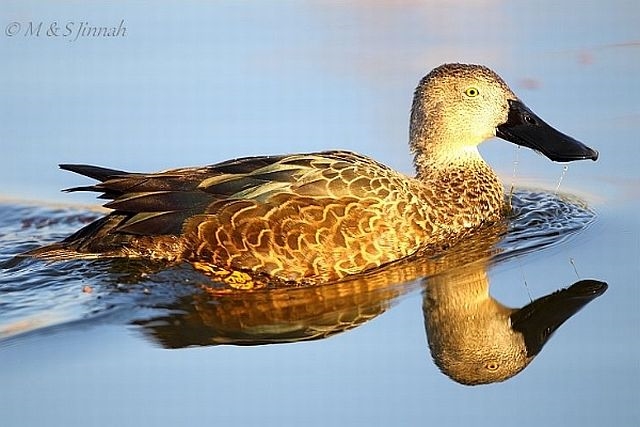 © Sharifa
© Sharifa
 © Sharifa
© Sharifa
 © Sharifa
© Sharifa
Garden Route National Park, Malachite Bird Hide, Wilderness
Links:
http://sabap2.adu.org.za/species_info.p ... #menu_left
http://www.oiseaux-birds.com/card-cape-shoveler.html
 © Dewi
© Dewi © Dewi
© Dewi © nan
© nanLamberts Bay
 © Sharifa
© Sharifa © Sharifa
© Sharifa © Sharifa
© SharifaGarden Route National Park, Malachite Bird Hide, Wilderness
Links:
http://sabap2.adu.org.za/species_info.p ... #menu_left
http://www.oiseaux-birds.com/card-cape-shoveler.html
- nan
- Posts: 26320
- Joined: Thu May 31, 2012 9:41 pm
- Country: Switzerland
- Location: Central Europe
- Contact:
Mallard
923. Mallard Anas platyrhynchos (Groenkopeend)
Order: Anseriformes. Family: Anatidae
Description
A dubbling duck. Size 50-65 cm.
Male is unmistakable with a bottle-green, glossy head, yellow beak, orange legs, white ring around the neck and a chestnut breast, black back, grey wings and white tail. When in eclipse plumage, male resemble female. Domesticated form of Mallard is the Khaki Canpbell, which looks very similar but is much larger and has a khaki (not grey) back.
Female is mottled brown all over, very similar to Yellow-billed Duck but has a grey, not yellow bill. Juveniles resemble females.
Distribution
Occurs across much of the Northern Hemisphere, largely excluding high mountains, deserts and tundra of the Arctic Circle, while also breeding in the area from Morocco to Algeria, heading to Sudan and Ethiopia in the non-breeding season. It is present in the Western Cape and Gauteng, but both populations are feral birds which probably escaped from wildfowl collections. Listed as an invasive alien species.
Habitat
Any area of open water. It generally prefers freshwater wetlands, sewage ponds and irrigation ponds; it is tolerant of disturbance by humans.
Diet
Omnivorous, feeding on a variety of insects and other invertebrates, as well as fish, amphibians and plant matter. It does most of its foraging by plucking food from the ground or water, often dabbling and up-ending.
Breeding
Monogamous, solitary nester, with pairs staying together for only a single breeding season, during which they perform elaborate and complex courtship displays. The nest is built solely by the female, consisting of a shallow depression with a rim of grasses, leaves and small twigs, well-lined with soft down and typically placed in dense vegetation near water. It may occasionally use a nest box or tree cavity instead of building its own nest. It lays 4-18 eggs, which are incubated solely by the female for 24-32 days. The chicks leave the nest within 14-21 hours of hatching, lead by the female to the water. She cares for and feeds them in the water until they take their first flight at 50-60 days old, at which point they become fully independent.This species is able to interbreed with closely related indigenous species such as the yellow-billed duck and the African black duck. The offspring are fertile, which means there is the risk of a complete dilution of the indigenous species.
Call
Male and female call similar to that of Yellow-billed Duck (male: rasping hiss, female: quacks).
Listen to Bird Call.
Status
Resident; feral populations in Gauteng and in the Western Cape, where there is some hybridisation with Yellow-billed Duck.
Order: Anseriformes. Family: Anatidae
Description
A dubbling duck. Size 50-65 cm.
Male is unmistakable with a bottle-green, glossy head, yellow beak, orange legs, white ring around the neck and a chestnut breast, black back, grey wings and white tail. When in eclipse plumage, male resemble female. Domesticated form of Mallard is the Khaki Canpbell, which looks very similar but is much larger and has a khaki (not grey) back.
Female is mottled brown all over, very similar to Yellow-billed Duck but has a grey, not yellow bill. Juveniles resemble females.
Distribution
Occurs across much of the Northern Hemisphere, largely excluding high mountains, deserts and tundra of the Arctic Circle, while also breeding in the area from Morocco to Algeria, heading to Sudan and Ethiopia in the non-breeding season. It is present in the Western Cape and Gauteng, but both populations are feral birds which probably escaped from wildfowl collections. Listed as an invasive alien species.
Habitat
Any area of open water. It generally prefers freshwater wetlands, sewage ponds and irrigation ponds; it is tolerant of disturbance by humans.
Diet
Omnivorous, feeding on a variety of insects and other invertebrates, as well as fish, amphibians and plant matter. It does most of its foraging by plucking food from the ground or water, often dabbling and up-ending.
Breeding
Monogamous, solitary nester, with pairs staying together for only a single breeding season, during which they perform elaborate and complex courtship displays. The nest is built solely by the female, consisting of a shallow depression with a rim of grasses, leaves and small twigs, well-lined with soft down and typically placed in dense vegetation near water. It may occasionally use a nest box or tree cavity instead of building its own nest. It lays 4-18 eggs, which are incubated solely by the female for 24-32 days. The chicks leave the nest within 14-21 hours of hatching, lead by the female to the water. She cares for and feeds them in the water until they take their first flight at 50-60 days old, at which point they become fully independent.This species is able to interbreed with closely related indigenous species such as the yellow-billed duck and the African black duck. The offspring are fertile, which means there is the risk of a complete dilution of the indigenous species.
Call
Male and female call similar to that of Yellow-billed Duck (male: rasping hiss, female: quacks).
Listen to Bird Call.
Status
Resident; feral populations in Gauteng and in the Western Cape, where there is some hybridisation with Yellow-billed Duck.
- nan
- Posts: 26320
- Joined: Thu May 31, 2012 9:41 pm
- Country: Switzerland
- Location: Central Europe
- Contact:
Mallard Photos
923. Mallard Anas platyrhynchos
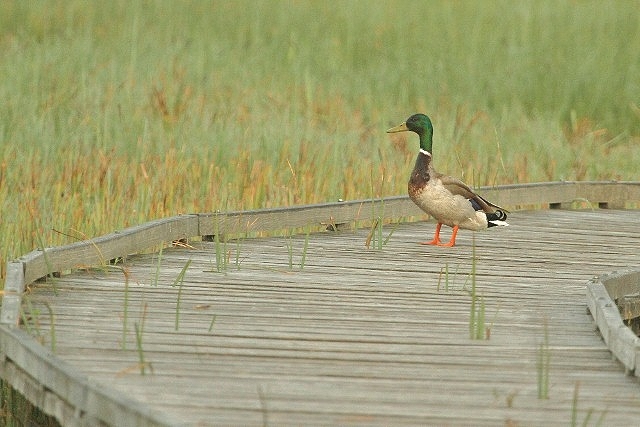
Male, Switzerland
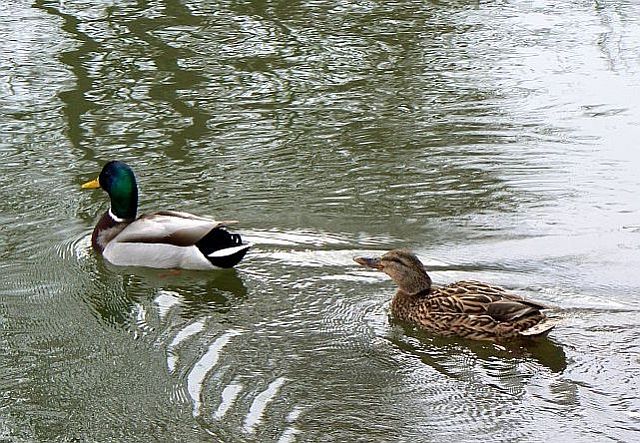 © Toko
© Toko
Male and female, Germany
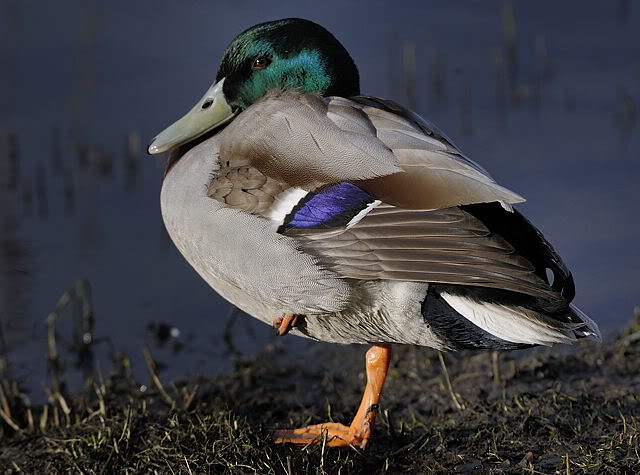 © Dewi
© Dewi
Male
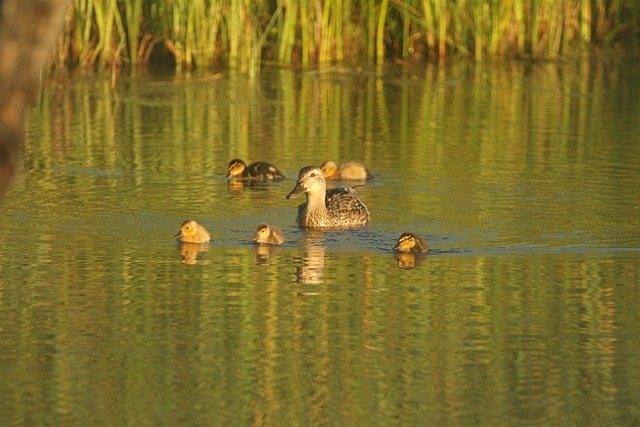
Female and chicks

Female
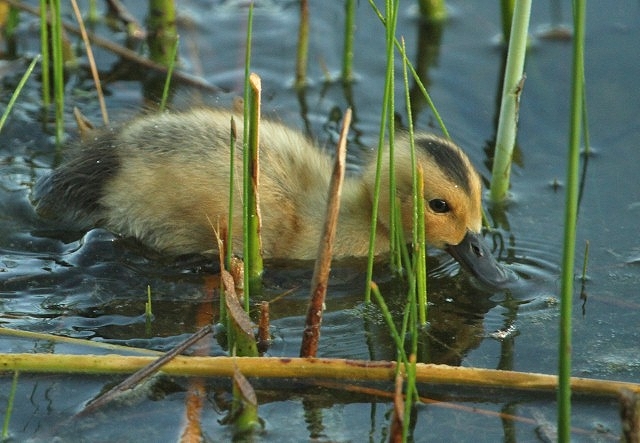
Chick
Links:
Sabap2
The Illustrated Encyclopedia Of European Birds
Oiseaux net

Male, Switzerland
 © Toko
© TokoMale and female, Germany
 © Dewi
© DewiMale

Female and chicks

Female

Chick
Links:
Sabap2
The Illustrated Encyclopedia Of European Birds
Oiseaux net
- Amoli
- Posts: 6032
- Joined: Fri Jun 01, 2012 4:30 am
- Country: South Africa
- Location: Kempton Park
- Contact:
Southern Pochard
113. Southern Pochard Netta erythrophthalma (Bruineend)
Order: Anseriformes. Family: Anatidae
Description
Size 48 to 51 cm. Weight 800 g. Small to medium-sized duck with characteristic red eye, blue-grey bill, black nail and grey legs and feet with black webs.
The male has a black head, neck and breast with a purple iridescence, bright red eyes, pale blue-grey beak with black tip, chestnut coloured flanks, dark brown tail, dark brown upperparts, and legs and feet are blue-grey to blackish. In flight, both sexes show a distinct white wing bar along the base of the flight feathers but lack a coloured speculum.
Female: Nape, back, scapulars, wings and tail as male, but paler; remainder of plumage lighter and browner. Head brown with white blaze at base of bill extending to chin and throat; white crescent starts behind eye and extends to foreneck. Extent and pattern of white very variable. Underparts from upper breast to undertail coverts mottled white, barred fulvous brown (mottling may be absent, giving darker appearance). Bill olive-grey, nail blackish. Eyes red-brown.
Immature: Like adult. Chick: Brownish black except for white belly; side of head white bordered below by brown stripe from bill to nape.
Similar species: Male told from Maccoa Duck in darker cokouring with uniform head and back, longer neck. Female differs from female Maccoa by whitish crescent on sides on head, white throat and bill-base.
Distribution
Found in North and South America, as well as in Africa south of the Sahara. (Eritrea and Angola through to southern Africa). N. e. brunnea is distributed from South Africa to Ethiopia. Southern African populations are concentrated in the southwestern Cape Province, South African highveld, southeastern Botswana, and northern Botswana to the Zimbabwean plateau. This common duck is a resident and spring/summer visitor in flocks of up to 5000 birds in the southwestern Cape Province. It is thinly distributed and nomadic in the Free State and Transvaal, and scarce in the Transvaal and Swaziland. Up to 200 birds may occur on the Nyl floodplain after good rains. In KwaZulu-Natal it is most common inland.
Taxonomy
There are two subspecies, the South American (Southern) Pochard N. e. erythrophthalma and the African (Southern) Pochard N. e. brunnea.
Habitat
In southern Africa it can be found where there are wetlands with deep, clear water and emergent vegetation. It chooses deep seasonal or permanent freshwater pans, vleis, sewage ponds and dams, usually with clear water, with or without emergent vegetation, and seasonal floodplains.
Movements
The African Pochard occurs from the Cape to the Ethiopian highlands on water bodies with or without emergent vegetation. They are suspected to have been strong migrants in the past but the construction of numerous farm dams seems to allow them a more sedentary lifestyle. t is quite mobile, as birds ringed in the North-West Province have been found in northern Namibia, and even Malawi, Zambia, Tanzania and Kenya, more than 3000 km away. They reach highest concentrations in Africa's central plateaus and in the south-western winter rainfall region.
Social Organization
This bird is sociable and gregarious. It has been seen in groups of up to 5,000.
Diet
It feeds mainly on plant products (water-lilies, seeds, rhizomes and corms, long-awned water grass leaves and fruits), with very small amounts of invertebrates (insects, gastropods, fluke snails) making up the rest of its diet. It usually forages by diving, sometimes travelling 18m. It also dabbles and, uncommonly, forages on waterside vegetation.
Breeding
Monogamous solitary nester, often with nests only a few metres apart. Courtship is elaborate, involving unique calls, preening, and head bobbing. The female builds the nest, using materials from nearby aquatic plants. The nest is a broad bowl, 30-40cm wide and about 8 cm deep, built with leaves and stems, sometimes lined with down feathers. It is usually placed in thick vegetation (e.g. reeds or sedges) on the water's edge or up to 20m away. Rarely, it uses old nests of Red-knobbed coot. It lays 4-15 eggs, at 1 day intervals, which are incubated by the female for 20-28 days. The chicks, once hatched, are immediately led by their mother to the water, as they know how to dive and swim by instinct, The chicks fledge at 49-65 days old. The chicks feed for themselves, with the female disturbing floating vegetation by sweeping its bill while the chicks grab bits of food. The chicks eat about 20% insects and 80% plant matter.
Call
Not very vocal; male gives soft prerr, prerr, female a nasal krrrow in flight. Listen to Bird Call.
Status
Common resident. The Southern Pochard is not threatened, in fact it has benefited greatly from human development.
Order: Anseriformes. Family: Anatidae
Description
Size 48 to 51 cm. Weight 800 g. Small to medium-sized duck with characteristic red eye, blue-grey bill, black nail and grey legs and feet with black webs.
The male has a black head, neck and breast with a purple iridescence, bright red eyes, pale blue-grey beak with black tip, chestnut coloured flanks, dark brown tail, dark brown upperparts, and legs and feet are blue-grey to blackish. In flight, both sexes show a distinct white wing bar along the base of the flight feathers but lack a coloured speculum.
Female: Nape, back, scapulars, wings and tail as male, but paler; remainder of plumage lighter and browner. Head brown with white blaze at base of bill extending to chin and throat; white crescent starts behind eye and extends to foreneck. Extent and pattern of white very variable. Underparts from upper breast to undertail coverts mottled white, barred fulvous brown (mottling may be absent, giving darker appearance). Bill olive-grey, nail blackish. Eyes red-brown.
Immature: Like adult. Chick: Brownish black except for white belly; side of head white bordered below by brown stripe from bill to nape.
Similar species: Male told from Maccoa Duck in darker cokouring with uniform head and back, longer neck. Female differs from female Maccoa by whitish crescent on sides on head, white throat and bill-base.
Distribution
Found in North and South America, as well as in Africa south of the Sahara. (Eritrea and Angola through to southern Africa). N. e. brunnea is distributed from South Africa to Ethiopia. Southern African populations are concentrated in the southwestern Cape Province, South African highveld, southeastern Botswana, and northern Botswana to the Zimbabwean plateau. This common duck is a resident and spring/summer visitor in flocks of up to 5000 birds in the southwestern Cape Province. It is thinly distributed and nomadic in the Free State and Transvaal, and scarce in the Transvaal and Swaziland. Up to 200 birds may occur on the Nyl floodplain after good rains. In KwaZulu-Natal it is most common inland.
Taxonomy
There are two subspecies, the South American (Southern) Pochard N. e. erythrophthalma and the African (Southern) Pochard N. e. brunnea.
Habitat
In southern Africa it can be found where there are wetlands with deep, clear water and emergent vegetation. It chooses deep seasonal or permanent freshwater pans, vleis, sewage ponds and dams, usually with clear water, with or without emergent vegetation, and seasonal floodplains.
Movements
The African Pochard occurs from the Cape to the Ethiopian highlands on water bodies with or without emergent vegetation. They are suspected to have been strong migrants in the past but the construction of numerous farm dams seems to allow them a more sedentary lifestyle. t is quite mobile, as birds ringed in the North-West Province have been found in northern Namibia, and even Malawi, Zambia, Tanzania and Kenya, more than 3000 km away. They reach highest concentrations in Africa's central plateaus and in the south-western winter rainfall region.
Social Organization
This bird is sociable and gregarious. It has been seen in groups of up to 5,000.
Diet
It feeds mainly on plant products (water-lilies, seeds, rhizomes and corms, long-awned water grass leaves and fruits), with very small amounts of invertebrates (insects, gastropods, fluke snails) making up the rest of its diet. It usually forages by diving, sometimes travelling 18m. It also dabbles and, uncommonly, forages on waterside vegetation.
Breeding
Monogamous solitary nester, often with nests only a few metres apart. Courtship is elaborate, involving unique calls, preening, and head bobbing. The female builds the nest, using materials from nearby aquatic plants. The nest is a broad bowl, 30-40cm wide and about 8 cm deep, built with leaves and stems, sometimes lined with down feathers. It is usually placed in thick vegetation (e.g. reeds or sedges) on the water's edge or up to 20m away. Rarely, it uses old nests of Red-knobbed coot. It lays 4-15 eggs, at 1 day intervals, which are incubated by the female for 20-28 days. The chicks, once hatched, are immediately led by their mother to the water, as they know how to dive and swim by instinct, The chicks fledge at 49-65 days old. The chicks feed for themselves, with the female disturbing floating vegetation by sweeping its bill while the chicks grab bits of food. The chicks eat about 20% insects and 80% plant matter.
Call
Not very vocal; male gives soft prerr, prerr, female a nasal krrrow in flight. Listen to Bird Call.
Status
Common resident. The Southern Pochard is not threatened, in fact it has benefited greatly from human development.
- Amoli
- Posts: 6032
- Joined: Fri Jun 01, 2012 4:30 am
- Country: South Africa
- Location: Kempton Park
- Contact:
Southern Pochard Photos
113. Southern Pochard Netta erythrophthalma
 © Amoli
© Amoli
Male & female
 Female © Sharifa
Female © Sharifa
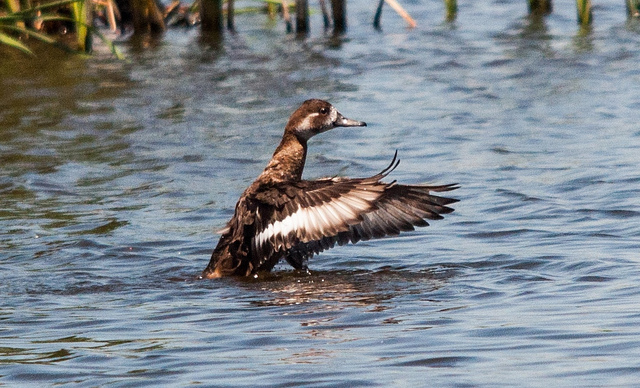 © steamtrainfan
© steamtrainfan
Marievale, Gauteng
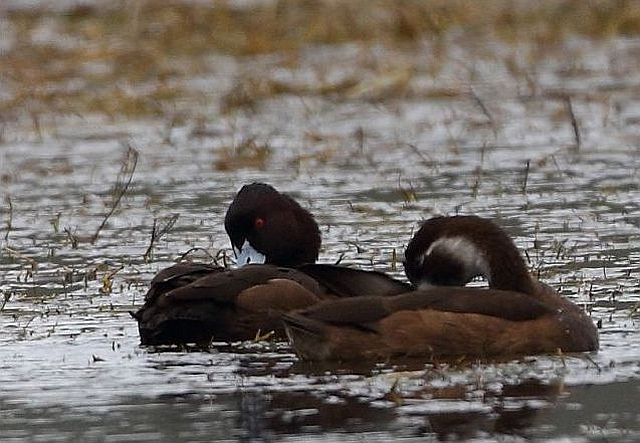 © Sharifa
© Sharifa
Garden Route National Park, Malachite Bird Hide, Wilderness
Links:
http://sabap2.adu.org.za/docs/sabap1/113.pdf
http://sabap2.adu.org.za/spp_summary.ph ... §ion=3
 © Amoli
© AmoliMale & female
 Female © Sharifa
Female © Sharifa © steamtrainfan
© steamtrainfanMarievale, Gauteng
 © Sharifa
© SharifaGarden Route National Park, Malachite Bird Hide, Wilderness
Links:
http://sabap2.adu.org.za/docs/sabap1/113.pdf
http://sabap2.adu.org.za/spp_summary.ph ... §ion=3
- nan
- Posts: 26320
- Joined: Thu May 31, 2012 9:41 pm
- Country: Switzerland
- Location: Central Europe
- Contact:
Maccoa Duck
117. Maccoa Duck Oxyura maccoa (Bloubekeend)
Order: Anseriformes. Family: Anatidae
Description
A small African stiff-tailed diving duck, 48–51 cm long. It has long stiff tail feathers erected at 45° when the bird is at rest. It also has a large swollen blue bill.
Adult males have a chestnut body in breeding plumage, a blue bill and a black head. Stiff tail is blackish. Seen in flight, upper wings are dark brown and under wings greyish white. Belly and undertail feathers are whitish. Back and rump are spotted with grey. Head and neck are black. Large swollen bill is bright blue with large whitish nail. Eyes are dark brown. Legs and webbed feet are grey.
Female and eclipse male have dark brown body. Crown is blackish but throat and cheeks are paler. We can see a whitish stripe under the eye. Bill is grey and less swollen in female than in male.
Juvenile resembles female with duller plumage, more uniform on body, lacking markings above, and more brown than grey below. It has pointed tail feathers. It needs at least one year to reach its adult plumage.
Similar species: The female may be confused with the female Southern Pochard but the latter has a vertical pale crescent behind the eye and not horizontal striping across the cheeks
Distribution
This duck breeds in two main areas: eastern Africa from Sudan and Ethiopia to Tanzania and west to eastern Zaire, and southern Africa from Zimbabwe to Cape Province, South Africa. It has a scattered distribution over most of southern Africa, but is mainly concentrated on the highveld (Gauteng, North-West Province, Mpumalanga and Free State), the Western Cape, and upland areas of KwaZulu-Natal.
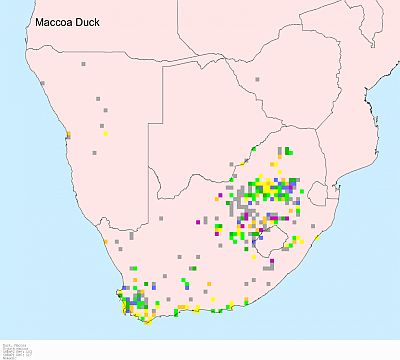
Habitat
Its breeding habitat is shallow fresh waters, and it is also found in brackish and saline lakes in winter. It prefers permanent wetlands that have rich concentrations of bottom-dwelling (benthic) invertebrates.
Diet
Small invertebrates (larvae and gastropods) and plant materials (seeds and roots).
Breeding
The male is promiscuous and can have up to eight females nesting simultaneously in his territory, which he guards against intrusion by other males. Males with inferior territories are ignored by females. Fights between males can occur both above and below water, and include under water chases and physical attacks where birds hold each other with their bills and beat each other with their wings. A male can be territorial and sexually active for at least four months. The nest is built by the female in emergent vegetation such as reeds (Phragmites), bulrushes (Typha) or sedges (Cyperaceae) growing in fairly deep water. It consists of leaves and stems from the surrounding vegetation pulled down and bent into bulky bowl, with eggs lying from 8-23 cm above water level. It is vulnerable to flooding because it is secured to the emergent vegetation. The nest is sometimes built on top of an old Great-crested Grebe or Red-knobbed Coot nest. Breeding season is year-round. The female lays a clutch of 2-9 eggs, each egg being laid at one to two day intervals. Clutches of more than nine eggs (up to 16 have been recorded) are the result of nest parasitism by other females. Incubation (by the female only) starts after clutch completion and takes 25-27 days before the eggs hatch. During this time she is on the nest for about 72% of the time, which uses up a lot of her energy. In fact, unless she lays down fat deposits greater than 20% of her body weight before nesting begins, she is unlikely to be able to endure this period of incubating and sometimes has to desert her clutch. Ducklings leave the nest soon after hatching and start diving and feeding for themselves immediately. Only the female stays with her brood and she does so for anything ranging from 2-5 weeks. Initially she keeps them in the vicinity of the nest and broods them on the nest at night. Nest parasitism is common: other than laying eggs in each other's nests, they have also been recorded laying them in Fulvous Duck, Egyptian Goose, Hottentot Teal, Southern Pochard and Red-knobbed Coot nests.
Status
Uncommon, nomadic resident. Classified as Near Threatened (NT) on the IUCN Red List.
Order: Anseriformes. Family: Anatidae
Description
A small African stiff-tailed diving duck, 48–51 cm long. It has long stiff tail feathers erected at 45° when the bird is at rest. It also has a large swollen blue bill.
Adult males have a chestnut body in breeding plumage, a blue bill and a black head. Stiff tail is blackish. Seen in flight, upper wings are dark brown and under wings greyish white. Belly and undertail feathers are whitish. Back and rump are spotted with grey. Head and neck are black. Large swollen bill is bright blue with large whitish nail. Eyes are dark brown. Legs and webbed feet are grey.
Female and eclipse male have dark brown body. Crown is blackish but throat and cheeks are paler. We can see a whitish stripe under the eye. Bill is grey and less swollen in female than in male.
Juvenile resembles female with duller plumage, more uniform on body, lacking markings above, and more brown than grey below. It has pointed tail feathers. It needs at least one year to reach its adult plumage.
Similar species: The female may be confused with the female Southern Pochard but the latter has a vertical pale crescent behind the eye and not horizontal striping across the cheeks
Distribution
This duck breeds in two main areas: eastern Africa from Sudan and Ethiopia to Tanzania and west to eastern Zaire, and southern Africa from Zimbabwe to Cape Province, South Africa. It has a scattered distribution over most of southern Africa, but is mainly concentrated on the highveld (Gauteng, North-West Province, Mpumalanga and Free State), the Western Cape, and upland areas of KwaZulu-Natal.

Habitat
Its breeding habitat is shallow fresh waters, and it is also found in brackish and saline lakes in winter. It prefers permanent wetlands that have rich concentrations of bottom-dwelling (benthic) invertebrates.
Diet
Small invertebrates (larvae and gastropods) and plant materials (seeds and roots).
Breeding
The male is promiscuous and can have up to eight females nesting simultaneously in his territory, which he guards against intrusion by other males. Males with inferior territories are ignored by females. Fights between males can occur both above and below water, and include under water chases and physical attacks where birds hold each other with their bills and beat each other with their wings. A male can be territorial and sexually active for at least four months. The nest is built by the female in emergent vegetation such as reeds (Phragmites), bulrushes (Typha) or sedges (Cyperaceae) growing in fairly deep water. It consists of leaves and stems from the surrounding vegetation pulled down and bent into bulky bowl, with eggs lying from 8-23 cm above water level. It is vulnerable to flooding because it is secured to the emergent vegetation. The nest is sometimes built on top of an old Great-crested Grebe or Red-knobbed Coot nest. Breeding season is year-round. The female lays a clutch of 2-9 eggs, each egg being laid at one to two day intervals. Clutches of more than nine eggs (up to 16 have been recorded) are the result of nest parasitism by other females. Incubation (by the female only) starts after clutch completion and takes 25-27 days before the eggs hatch. During this time she is on the nest for about 72% of the time, which uses up a lot of her energy. In fact, unless she lays down fat deposits greater than 20% of her body weight before nesting begins, she is unlikely to be able to endure this period of incubating and sometimes has to desert her clutch. Ducklings leave the nest soon after hatching and start diving and feeding for themselves immediately. Only the female stays with her brood and she does so for anything ranging from 2-5 weeks. Initially she keeps them in the vicinity of the nest and broods them on the nest at night. Nest parasitism is common: other than laying eggs in each other's nests, they have also been recorded laying them in Fulvous Duck, Egyptian Goose, Hottentot Teal, Southern Pochard and Red-knobbed Coot nests.
Status
Uncommon, nomadic resident. Classified as Near Threatened (NT) on the IUCN Red List.
- nan
- Posts: 26320
- Joined: Thu May 31, 2012 9:41 pm
- Country: Switzerland
- Location: Central Europe
- Contact:
Maccoa Duck Photos
117. Maccoa Duck Oxyura maccoa
 © nan
© nan
Male, False Bay, Western Cape
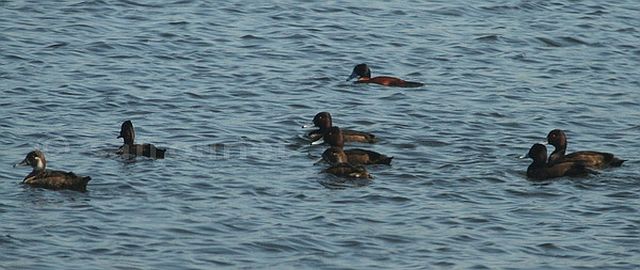 © nan
© nan
Male Maccoa in the background, Southern Pochards in the foreground, False Bay, Western Cape
Links:
Species Text Sabap1
Sabap2
 © nan
© nanMale, False Bay, Western Cape
 © nan
© nanMale Maccoa in the background, Southern Pochards in the foreground, False Bay, Western Cape
Links:
Species Text Sabap1
Sabap2


